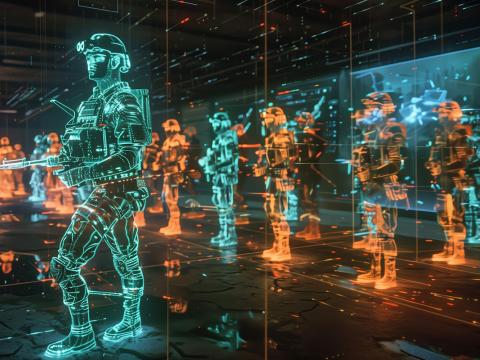Enabling Artificial Intelligence at the Combatant Commands
The Department of Defense's Office of the Chief Information Officer, or DoD CIO, is pursuing several efforts to make sure the U.S. combatant commands have the fundamental tools to enable artificial intelligence and machine learning to aid their operational command and control.
The DoD CIO’s efforts naturally hinge on data and data management, an appropriate transport layer and future cloud capabilities, solutions that will benefit a broad range of warfighters not just at the commands, said Kelly Fletcher, who is performing the duties of the department’s chief information officer on behalf of John Sherman, the nominated CIO who is currently going through his confirmation process for the position and testifying tomorrow in front of the U.S. Senate. A senior executive service official, Fletcher has been working in the office since 2020.
She presented a keynote address during AFCEA International’s TechNet Cyber conference in Baltimore on October 27.
Fletcher emphasized that the DoD CIO’s office supports more than 40 major combatant commands, services and agencies, “and they all have unique requirements,” she said. The DoD’s networks are globally distributed, have multiple classification levels “and are constantly evolving.” The office is committed to innovating this widespread infrastructure and associated data management to better support warfighter operations and decision makers.
“I think that now we are prioritizing correctly, and what I think our leadership really appreciates us prioritizing is transitioning the department to be a data-driven organization,” Fletcher offered. “We want to empower leaders with the right data, at the right time, and we want them to be able to make the right decision and have that decision informed by AI [artificial intelligence] or advanced analytics and frankly all of the relevant data.”
Dr Kelly Fletcher acting @DoD_CIO explains that one of their goals is to accelerate data driven capabilities, and especially in support of the U.S. combatant commands.But there are different levels of data maturity
— Kimberly Underwood (@Kunderwood_SGNL) October 27, 2021
at each combatant command #AFCEACyber pic.twitter.com/MztOKVCotc
One effort that prioritizes improved data solutions is the new Artificial Intelligence and Data Accelerator (AIDA) initiative, named for Ada Lovelace, who is considered to be one of the first computer programmers. Deputy Defense Secretary Kathleen Hicks announced the department’s pursuit of the initiative in June.
“The goal is really to accelerate data-driven capabilities in support of the U.S. combatant commands,” Fletcher noted. “We are seeing across the combatant commands that there are different levels of data maturity. They have different data sets and they have wildly diverse missions. What we're doing with AIDA is we're trying to enable the combatant commands to identify where they have data that would benefit the enterprise, and where they have data that would be beneficial to sort of mash it up internal to themselves. And we want to enable them to be successful with some of the tools that have been created at the enterprise level.”
The DoD CIO’s office is in the process of sending out data and AI teams to each combatant command, Fletcher shared.
“The teams are working with the combatant command to understand where [the teams] can be most helpful,” she explained. “Not only will they bring out a tool kit, but in addition, they can say, ‘Hey what data do you have?’ or ‘What are your key problems that you are trying to solve?”
Fletcher predicted that interaction with the commands and the resulting information gathered by the teams will highlight further areas of improvement.
“I think this is really exciting for a couple of reasons,” she stated. “We are going to find out that we have challenges in data that we didn't even know about, and then also from a DoD CIO perspective, I think we're going to see what is limiting the commands. Do the commands have the transport they need, do they have the compute power, and is it in the right place? Do they have the workforce they need and is that workforce scaled to meet their requirements? These are direct enablers, and they are enablers that I think we in this community are responsible for providing.”
The DoD CIO also is working on improving the military’s transport layer, especially in a near-peer threat environment. “Transport is really critical and its tricky,” Fletcher suggested. “I think in a lot of places we have stable, secure, resilient and predictable transport performance and that is awesome. We are increasing bandwidth across the Department of Defense, we're getting rid of single points of failure. We are doing a lot of smart things in this domain. But where I'm really interested in and excited about is in the deny, disrupt, intermittent and limited bandwidth space, where we're at the edge.”
For those tactical network end points, the DoD CIO wants to “enable transport as much as we can,” she said. “But I also want to acknowledge that in some cases we are going to be disconnected, and we are going to have to figure out how to fight through that.”
Fletcher added that transport is a critical aspect of joint all-domain command and control, or JADC2.
“JADC2 is 100 percent reliant on transport,” she pointed out. “The goal of JADC2 is to connect systems, data and decision makers across the department to enable better and faster operational decisions. And what we can do to support JADC2 is to develop more resilient communications. We also want to enable AI, machine learning to get into that mix. We want to make sure that this underlying infrastructure of the transport works to support all of this.”





Comments